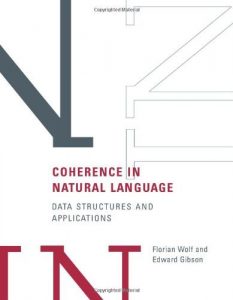In Coherence and Natural Language, Florian Wolf and Edward Gibson specify
and evaluate criteria for descriptively adequate data structures for representing
discourse coherence. They test the influence of discourse structure on pronoun
processing, evaluate different approaches for determining the relative importance of
document segments, and propose a new coherence-based algorithm to accomplish this
task. Their book offers the first large-scale empirical evaluation of data
structures for representing coherence and also includes novel psycholinguistic tests
of existing information extraction and text summarization systems.Wolf and Gibson
evaluate whether tree structures are descriptively adequate for representing
discourse coherence and conclude that more powerful data structure is needed because
there are many different kinds of crossed dependencies and nodes with multiple
parents in the discourse structures of naturally occurring texts. They propose that
connected, labeled chain graphs make a better representation of coherence. They find
additionally that causal coherence relations affect people's strategies for pronoun
processing, which points to the psychological validity of coherence relations.
Finally, they evaluate word-based, layout-based, and coherence-based approaches for
estimating the importance of document segments in a document and find that
coherence-based methods that operate on chain graphs perform best. With its
attention to empirical validation and psycholinguistic processing, the book raises
issues that are relevant to cognitive science as well as natural language processing
and information extraction.
Este sitio es seguro
Usted está en un sitio seguro, habilitado para SSL. Todas nuestras fuentes son constantemente verificadas.



